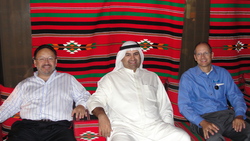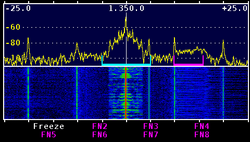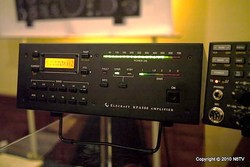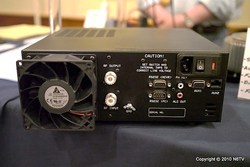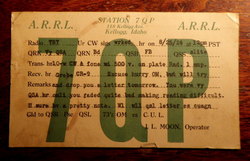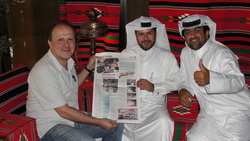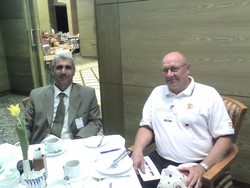 April 28, 2010 Editor: Ward Silver, NØAX | ||||||||
IN THIS ISSUE
NEW HF OPERATORS - THINGS TO DO If you are looking to pick up the very large and very small states, this is the weekend for you! The two biggest regional QSO parties (contests in which several states pool their contest resources) for the 7th district (the 7QP) and the New England division (NEQP) will fill the bands this weekends. Pay particular attention to the county abbreviations - and keep an ear tuned for the Indiana and Nevada operators, too! BULLETINS There are no bulletins in this issue. BUSTED QSOS Charles W6DPD writes in with more information about the Wouff Hong reproduction featured in the last issue. "The picture of the Wouff Hong is from the 1939 Fresno Hamfest that was actually sponsored by the San Joaquin Valley Radio Club. In 1957 the San Joaquin Valley Radio Club became the Fresno Amateur Radio Club." CONTEST SUMMARY Complete information for all contests follows the Conversation section May 1-2
May 8-9
The Amateur Radio Antenna Defense Foundation, or ARADF, has just been approved by the Internal Revenue Service as a public charity under Section 501(c)(3) of the Internal Revenue Code. The organization's CFO, Marty N6VI announces, "Amateurs seeking to install antennas and support structures may jump through local regulatory hoops, sometimes paying significant fees in the process, only to be turned down or to be burdened with severe restrictions that preclude effective communication. Turning to the courts can be prohibitively costly for the ham, while cities have taxpayer-funded attorneys on staff, giving them the upper hand. The goal of ARADF is to help level the playing field with financial assistance that will allow deserving antenna lawsuits to go forward." ARADF will concentrate on lower-court cases and is supportive of but not affiliated with the American Radio Relay League. A Web site is being developed and should be online shortly. (Thanks, Dennis N6KI)
The WRTC-2010 committee announces the Russian Youth Team of young contesters Anton Navnychko RX9TL as a Team Leader and Yuri Hmelenko RL3FT as his Team Mate. As the committee says, "These guys are the future for Russian contesting so we wish them good luck!" You can also meet some of the WRTC-2010 Committee in person at Dayton. Andy UA3AB will be there along with Krassy K1LZ, the North American representative for WRTC-2010. They have a booth reserved and will be there to answer questions and publicize the event. The Contest Update's Mexico Bureau Chief, Ramon XE1KK, checks in with this dispatch from the Doha Regional Conference on Amateur Radio. "The conference was a big success and you can read about it on the IARU Region I Web site. From the contester perspective this meeting was an unusual opportunity to meet friends from the region, visit their stations and even have a taste of their pileups. Meeting most of the A73A contest team (Abdulla A71CV, Rashid A71AD and Dave K5GN/A7) was a pleasure. Meeting them after the event, as well as Mohammad A71EL and Rached A71AN, was a unique opportunity. Hamad 9K2HN and Faisal 9K2RR, Team Kuwait for WRTC 2010, were also in Doha as well as Olli OHØXX, Sergio PP5JR (ZX5J), Hans PB2T, among others. Contesting is alive in the Persian Gulf Region and we should see more of it in the months to come." Here comes the Dayton Hamvention and with it, a whole batch of contest-related activities! Tim K3LR sends this list of Web URLs to help you finalize your Dayton plans: Four Days of Contesting activities at Dayton is a PowerPoint slide show from KA9FOX.
The PVRC Webinar "Contest Activities at Dayton" also covers the excitement and, of course Contest University is still signing up students until May 3, including a Facebook page and Twitter feed. The 18th annual Contest Dinner features W5ZN as the main speaker and night after night of Contest Super Suites will feed your hunger for contesting camaraderie (and pizza)!
The International DX Convention in Visalia, CA played host to the introduction of two new products by Elecraft. The P3 panadapter accessory for the K3 was front and center, displaying received signals across a wide swath of the bands, including a waterfall display. Right next to it, a surprise product was also introduced - the KPA-500 solid-state amplifier. Weighing only 22 pounds and running off ac power, this completely self-contained unit will fit in your carryon luggage with room to spare and add punch to your signal from 160 through 6 meters.
Just up the aisle, I noticed a familiar face: Tom N6BT may have sold Force 12 Antennas to new owners, but you just can't keep an antenna designer down for long. Next Generation Antennas is developing a series of portable multi-band verticals (Bravo-5, -5K, and -7K) with an emphasis on efficiency. Tom's antenna book, "A Ray of Light", has been expanded to 290 pages and is once again in print, as well. Force 12 was also at the convention with their ever-expanding line of antennas. Another Visalia vendor was showing off a new product, too - Flex-Radio Systems. The new FLEX-1500 HF-6M QRP Software-Defined Radio was attracting attention with an introductory price and big SDR features. The radio weighs in at 1.2 pounds (you have to provide the host PC, of course) and has a transverter interface that makes it an interesting candidate for VHF+ contesters who want top-drawer performance. Those of you getting ready for a trip to the Dayton Hamvention will want to take in a new feature - the "Discover Homebrew" demonstration area in the North Hall. Sponsored by Hamvention and supported by the members of the Midwest VHF/UHF Society (MVUS), table will be available for anyone will be able to show off projects on Friday and Saturday - no sales will be permitted, demo only please. AC power and HF (possibly VHF, too) antenna access will be provided. If you're interested in exhibiting your work, please contact us Discover Homebrew at exhibits@hamvention.org. (Thanks, Hamvention Inside Exhibit Chairman, Scott AC8DE) The new ARRL Web site has a lot of features, but the new organization may have rendered your old Web site bookmarks obsolete. From the latest ARRL Propagation Bulletin, here's a list that may help you reconnect with old friends or add some new ones: Here's a tip from Randy K5ZD - "Is your log in ADIF format? Use LM by DL8WAA to convert it to Cabrillo." This is a handy utility if you are using a general-purpose logging program to record your contest QSOs. Remember that submitting contest logs in Cabrillo format greatly reduces the workload for the volunteers that make contesting work!
This coming weekend is a big one on the QSO party circuit as the 7QP, INQP, and NEQP all take place on May 1-2. Chuck NO5W has developed a Multi-QP module for 7QP+NEQP+INQP for his free CQ/X logging software. Using the Multi-QP modules you can log all of the QSO parties at the same time, then split the log into individual components into Cabrillo-formatted logs for the individual contests. At its annual board meeting last weekend, the Northern California DX Foundation (NCDXF) elected two new directors, Kip W6SZN and John K6MM, bringing the board complement back to eleven members. W6OAT, K6ANP, and K6RIM recently retired after many years of dedicated service to NCDXF. (Thanks, NCDXF Vice President, Glenn WØGJ) While the ANARTS contest is kaput, it is being replaced with a new RTTY contest. Goetz DJ3IW writes, "The DL-DX RTTY Contest Group has decided to give the defunct ANARTS RTTY Contest a new home. The contest will be continued though with some changes and a new name: DRCG Long Distance Contest or DLDC. The ANARTS points table and multiplier scheme stay in effect, VK bonus points are removed and the contest will be run in three 8-hour parts on the second full weekend of June. (12 June this year) A new 6-hour class has been added." See the DLDC Web site for complete information. There is one less Voo-Dude contester following the untimely passing of Vince Thompson K5VT. Diagnosed very recently with leukemia, Vince was unable to tolerate the resulting therapy. As a member of the Voo-Dude contest team, Vince was instrumental in putting West African multipliers in all of our logs. In addition, he was a friendly face at hamfests and conventions, never lacking for a humorous remark. He is already missed by us all. (Thanks, Roger G3SXW and Tony N7BG) Web Site of the Week - As recently announced, individual Mexican states have been added to the list of multipliers for the ARRL 10 Meter contest. Most US contesters are unfamiliar with the names and locations of those states. Ramon XE1KK came to our rescue with this map so that it is easy to understand the geography of Mexico and the rarity of each state. (Thanks, Hector XE2K) WORD TO THE WISE Skew - a propagation path not along a great-circle bearing between two stations. Skew path contacts often precede a band opening or follow a band closing over a direct path. For example, as 15 or 10 meters closes between the US and Japan or Europe, try pointing your beam somewhat south of the direct path. Signals will be weaker than direct path and exhibit deep fades. The opening will also cover a smaller area than a direct opening. If you haven't seen the photos from the new Solar Dynamics Observatory, you should definitely check out the articles on the platform's "first light". We are going to learn a whole lot about the Sun from this new instrument! (Thanks, Doug N6RT) Paul WB2ABD sent a link to an Information Week story about the Large Hadron Collider's recent return to operation in late March. What is the fellow in the third picture doing? It certainly looks familiar! The Astronomy Picture Of the Day site has had some great shots lately. For example, here are photos and link to a movie view of the largest solar prominence ever seen - by the SDO mentioned above. Another day's treat was this detailed photo and discussion of the granules that make up the surface of the Sun. Finally, a schematic diagram that includes the magic smoke - the "fifth component" after the resistor, capacitor, inductor, and memristor. Ham radio is performance art - we all know this to be true -- but here's the Web site for an artist featuring ham radio in some of her works. In this case, she began with HAM as Hold All Movement, but encountered the Seattle-area's Mike and Key Club along the way. Now studying for a ham license, Ms Allin is incorporating radio into her project. (Thanks, Dink N7WA) CQ WW Director, Bob K3EST says in his 14 April CQ WW Update that more than 12,000 entries were received for last fall's contests - a 17% increase over 2008! CQ WW is also forming regional support groups to improve communications with the CQ WW committee. Watch for log reports to be available in early May and open logs will follow soon after. Timo OH1NOA wants us to know that he still maintains his online list of the best QSO rates in contests. If you have updates, please send them to him! OPERATING TIP A couple of reasonable questions about contests beginning and ending are answered in this week's tip. Question 1 - "Can I call CQ before the start of the contest or do I have to wait until 0000Z?" You can call CQ all you want at any time, but if you call CQ TEST, meaning that you are soliciting contest QSOs, that has to take place after the contest starts. Question 2 - "Can I log a QSO that started during the contest but finished after the contest's ending time?" Assuming your PC clock is perfectly synchronized, the time at which you complete the QSO's over-the-air transmissions must be within the contest period. Summarizing - your over-the-air contest activity (including receiving) can only take place from the starting whistle to the ending whistle. The halo is a popular omnidirectional antenna for VHF+ rovers and not so difficult to homebrew. The gamma match (if one is used) and the resonating capacitor at the loop's gap often give the most trouble with fabrication and tuning. Here's an article with good photos of how W3DHJ built his halo. (Thanks, Dennis KC9IXO)
Clint Turner, KA7OEI has created a very helpful new Web page for those who've always wanted to try long distance laser communications. Clint has completed light QSOs over a record 107 km! You'll find circuits, tips of modifying the Ramsey Electronics laser communicator kit, and practical approaches to extending distance. (Thanks, Les N1LF) If your tower uses galvanized hardware, DON'T drill out the holes to make it easier to insert the bolts or screw them in. Use a taper or drift pin punch to open the hole until the bolt just fits, preserving the galvanizing on the hole. Drilling out the hole or using the screw threads to open the hole removes or damages the galvanizing, leading to rust problems. A taper pin punch can also be used to line up the holes when connecting section, so be sure to keep one in your tower tool kit! (Thanks, Roger K8RI) Another common hardware problem is galling of stainless steel threaded parts. Galling is created by surface micro-defects that essentially pressure-weld the parts together. Towertalk reflector discussions point out that the solution is to use an anti-seize compound such as Never-Seez on the threads. A very light coating of grease is another option, but don't overdo it. Galling can also be reduced by not over-tightening stainless steel parts. Lynn N7CFO relays information about Strapworks, a company that sells a plethora of straps and rigging supplies that would be handy for tower work or for a VHF+ rover-mobile.
At this past weekend's Idaho State Convention in Boise, I found a cool item that will interest vertical builders: the GuyTie® from Rampro. It's a plastic ring that slips over the tubing of a vertical and provides numerous rings for attaching guys. There are a number of sizes and I instantly thought of many times I'd wished for something like the GuyTie. Another handy tip I got from Jim KC7NN while in the lunch line was about using Rhino Deck® material for antenna construction. Rhino Deck is made from recycled HDPE, is UV-resistant, and can be worked with regular saws, drills, and hand-tools. Jim has given a piece the microwave oven test and it is apparently RF-inert, too. The handrail section he handed me looked like the perfect small Yagi boom and was apparently none the worse for having been outside for five years. Technical Web Site of the Week - Technical professionals and designers, take note of Besser & Associates' upcoming free Webinar, "Impedance Matching in HF Circuits". Not all of the pro action is above 1 GHz! The list of topics to be covered includes Energy Transfer in an RF Circuit, Conjugate Match, Using the Smith Chart, Match Bandwidth and Q, Matching in Several Steps, Transmission Line Transformers, and Device Measurements - Network Analyzer. All very useful! You can register for the live Webinar or watch an archived version. CONVERSATION Too Much Of A Good Thing Communication - we're all about communication in ham radio and contests stress communications skills, so how could there be too much communication? When communication before the contest starts taking the place of communication during the contest, that's too much communication! Contests set up limits and rules to exercise specific types of communication activity. There are limits on bands and modes of operation. Participants are required to exchange specific information. There are rules about permitted types of operating. All of these set up a certain type of game, just like in athletics. And just like in athletic events, the game is conducted between specific times or over a specific duration. We all accept that for athletic events, communication about the conduct of the game outside the time limits for the game is very strictly controlled. For example, the history of a participant's performance may be discussed at length, but discussing the specifics of how a participant will play during an event, except in broad strategic terms, is not allowed. After the event, the conduct of the game is again open to be discussed at length, of course. It would be absurd for a baseball pitcher to tell the hitters before the game, "You already know I have a fastball, sinker, and change-up. I'm going to throw the fastball in the second inning, the change-up in the third, and the sinker in the fourth. Enjoy!" It would spoil the game because it removes elements of strategy and skill from the competition. Yet before a ham radio contest, I find this sort of information being exchanged regularly in the form of pre-contest schedules. Before continuing, I'm going to let the VHF+ contest community off the hook on this issue. There is a lot of discussion about technological reasons for VHF+ contesters to consider schedules acceptable. Pre-contest schedules may be an open issue on VHF+, but it has long been decided on HF that they diminish the quality of the event and should not be made. The ARRL's "HF Contesting - Good Practices, Interpretations & Suggestions" - a white paper on contest operating practices - is clear: "if by announcing your information, another contester can tune to a specific frequency at a specific time and work you", that's over the line. For example, it's fine for someone operating in a state QSO party to let everybody know that they'll be driving through a list of counties and even give a general idea of the route and the order in which the counties will be activated. That increases interest and participation in the contest - go for it! However, when the information expands the detail to "NØAX will be in County X at time Y on frequency Z", that's a pre-contest schedule - don't do it. There is an exception to the no-schedule rule - schedules made during the contest and using the allowed contest bands and modes are acceptable. For example, during the contest it's OK to say, "I'm headed for Podunk County and should be on from there at 0300 on 3830 kHz." You are using the bands and modes the contest is designed to exercise. But before the contest? Unacceptable. Similarly, don't use Internet chat rooms or spotting networks to distribute the information while the contest is underway - those are outside the required bands and modes, and is considered self-spotting. There is a fine line between what's acceptable and what's not - the circumstances may not always be entirely clear - and our enthusiasm and competitiveness can lead us over it. If you're not sure about something, start by reading and understanding the contest rules - all of them. You can ask an experienced contester or two. The discussion will help you understand what practices are good and bad and why. The HF Guidelines mentioned above touch on many ethical points of contesting. As you spend more and more time contesting, evaluating behavior and deciding what is and isn't across that line, you'll develop a sense for when that quiet voice is whispering, "Too much". CONTESTS 28 April through 11 May An expanded, downloadable version of QST's Contest Corral in PDF format is available. Check the sponsor's Web site for information on operating time restrictions and other instructions. HF CONTESTS MARAC CW and SSB Contests--Phone,CW, from May 1, 0000Z to May 2, 2400Z. Bands (MHz): 3.5-28, 50-432, Frequencies (MHz): 3.550, 7.050, 14.050, 21.050, 28.050. Exchange: RS(T), state, county abbreviation. Logs due: May 31. Rules 10-10 Spring Digital Contest--Digital, from May 1, 0001Z to May 2, 2359Z. Bands (MHz): 28. Exchange: Call sign, name, 10-10 number, state. Logs due: 15 days. Rules QRP-QRP-Party--CW, from May 1, 1300Z to May 1, 1900Z. Bands (MHz): 3.5,7. Exchange: RST, serial, category. Logs due: May 31. Rules 7th Area QSO Party--Phone,CW,Digital, from May 1, 1300Z to May 2, 0700Z. Bands (MHz): 1.8-28, 50,144, Frequencies (MHz): CW--40 kHz above band edge; SSB--1.845, 3.855, 7.235, 14.255, 21.355, 28.455. Exchange: State and county code. Logs due: Jun 5. Rules Indiana QSO Party--Phone,CW, from May 1, 1600Z to May 2, 0400Z. Bands (MHz): 1.8-28. Frequencies (MHz): CW--1.805 and 40 kHz above the band edge on 80-10 meters, SSB--1.845, 3.820, 7.190, 14.250, 21.300, 28.400. Exchange: RS(T) + S/P or IN county, DX RS(T) only. Logs due: Jun 15. Rules Radio Club of America QSO Party--Phone, from May 1, 1700Z to May 2, 0459Z. Bands (MHz): 3.5-21. Exchange: RS, QTH, name, equipment. Rules ARI International DX Contest--Phone,CW,Digital, from May 1, 2000Z to May 2, 1959Z. Bands (MHz): 1.8-28. Exchange: RS(T), serial or Italian province. Logs due: 30 days. Rules New England QSO Party--Phone,CW,Digital, from May 1, 2000Z to May 2, 0500Z and May 2, 1300Z to May 2, 2400Z. Bands (MHz): 3.5-28. Frequencies (MHz): CW--3.540, 7.035, 14.040, 21.040, 28.040; SSB--3.850, 7.180/280, 14.280, 21.380, 28.380. Exchange: RS(T) and S/P or New England county. Logs due: 30 days. Rules Armed Forces Comm'ns Test--Phone,Digital, from May 8, 1200Z to May 9, 2400Z. Bands (MHz): 1.8-28. Frequencies (MHz): See Web site for specific station schedules. Exchange: RS(T). Logs due: no logs. Rules CQ-M International DX Contest--Phone,CW, from May 8, 1200Z to May 9, 1200Z. Bands (MHz): 1.8-28. Exchange: RS(T) and serial. Logs due: 30 days. Rules Alessandro Volta RTTY DX Contest--Digital, from May 8, 1200Z to May 9, 1200Z. Bands (MHz): 3.5-28. Exchange: RST, serial, CQ zone. Logs due: Jun 30. Rules Portuguese Navy Day--Phone,CW, from May 8 , 1500Z to May 9, 1500Z. Bands (MHz): 3.5-28. Exchange: RS(T), serial, CQ zone. Logs due: 20 days. Rules FISTS Spring Sprint--CW, from May 8, 1700Z to May 8, 2100Z. Bands (MHz): 3.5-28. Exchange: RS(T), S/P/C, name, FISTS nr or power. Logs due: 30 days. Rules Nevada QSO Party--Phone,CW,Digital, from May 8, 1700Z to May 9, 1700Z. Bands (MHz): 1.8-28, 50, Frequencies (MHz): CW--15 kHz and SSB 25 kHz above General band edge. Exchange: RS(T) and S/P/C or NV county. Logs due: Jun 15. Rules 50 MHz Spring Sprint--Phone,CW,Digital, from May 8, 2300Z to May 9, 0300Z. Bands (MHz): 50. Exchange: Grid Square (6-character preferred). Logs due: 14 days. Rules VHF+ CONTESTS VHF Spring Sprints--Phone,CW,Digital, from Apr 28, 7 PM to Apr 28, 11 PM. Bands (MHz): 432. Exchange: Grid Square (6-character preferred). Logs due: 14 days. Rules Microwave Spring Sprint--Phone,CW,Digital, from May 1, 6 AM to May 1, 1 PM. Bands (MHz): 902+. Exchange: Grid Square (6-character preferred). Logs due: 14 days. Rules 2 GHz and Up World Wide Contest--Phone,CW,Digital, from May 1, 6 AM to May 2, 8 PM. Bands (MHz): 2.4G+. Exchange: 6-char grid locator. Logs due: 60 days. Rules MARAC CW and SSB Contests--Phone,CW, from May 1, 0000Z to May 2, 2400Z. Bands (MHz): 3.5-28, 50-432, Frequencies (MHz): 3.550, 7.050, 14.050, 21.050, 28.050. Exchange: RS(T), state, county abbreviation. Logs due: May 31. Rules 7th Area QSO Party--Phone,CW,Digital, from May 1, 1300Z to May 2, 0700Z. Bands (MHz): 1.8-28, 50,144, Frequencies (MHz): CW--40 kHz above band edge; SSB--1.845, 3.855, 7.235, 14.255, 21.355, 28.455. Exchange: State and county code. Logs due: Jun 5. Rules Nevada QSO Party--Phone,CW,Digital, from May 8, 1700Z to May 9, 1700Z. Bands (MHz): 1.8-28, 50, Frequencies (MHz): CW--15 kHz and SSB 25 kHz above General band edge. Exchange: RS(T) and S/P/C or NV county. Logs due: Jun 15. Rules 50 MHz Spring Sprint--Phone,CW,Digital, from May 8, 2300Z to May 9, 0300Z. Bands (MHz): 50. Exchange: Grid Square (6-character preferred). Logs due: 14 days. Rules LOG DUE DATES 28 April through 11 May April 29 - RSGB 80m Club Championship, Data, upload log at: http://www.vhfcc.org/cgi-bin/hfenter.pl, paper logs and diskettes to: (none). Rules April 30 - Oklahoma QSO Party, email logs to: logs@okdxa.org, paper logs and diskettes to: Oklahoma QSO Party, OK DX Association, P.O. Box 2591, Claremore, OK 74018-2591, USA. Rules April 30 - ARLHS Annual Spring Lites QSO Party, email logs to: (none), paper logs and diskettes to: Dave Ruch, NF0J, P.O. Box 20696, Bloomington, MN 55420-0696, USA. Rules April 30 - SP DX Contest, email logs to: spdxc-logs@pzk.org.pl, paper logs and diskettes to: Polski Zwiazek Krotkofalowcow, SPDX Contest Committee, P. O. Box 320, 00-950 WARSZAWA, POLAND. Rules May 1 - BARTG HF RTTY Contest, email logs to: ska@bartg.org.uk, paper logs and diskettes to: (none). Rules May 1 - Feld Hell Sprint, email logs to: (none), Post log summary at: http://sites.google.com/site/feldhellclub/Home/contests, paper logs and diskettes to: (none). Rules May 1 - North Dakota QSO Party, email logs to: w0cq@arrl.org, paper logs and diskettes to: W0CQ, c/o Lynn Nelson, K0LN, 6940 4th St. SW, Minot, ND 58701, USA. Rules May 1 - Radio Maritime Day, email logs to: F6DGU@cyberelec.fr, paper logs and diskettes to: (none). Rules May 2 - UBA Spring Contest, SSB, email logs to: ubaspring@uba.be, paper logs and diskettes to: Michel Gerits, ON4CAQ, Mommestraat 69, B-3550 Heusden Zolder, Belgium. Rules May 2 - EU Spring Sprint, SSB, email logs to: eusprint@kkn.net, paper logs and diskettes to: Hrvoje Horvat, 9A6XX, 25 Rujan 4, HR-52000 Pazin, Croatia. Rules May 4 - ARCI Spring QSO Party, email logs to: va3jff@yahoo.ca, paper logs and diskettes to: ARCI Spring QSO Party, c/o Jeff Hetherington, VA3JFF, 139 Elizabeth St. W., Welland, Ontario L3C 4M3, Canada. Rules May 4 - Missouri QSO Party, email logs to: moqsoparty@w0ma.org, paper logs and diskettes to: Boeing Employees' Amateur Radio Society W0MA, 7488 Cornell Ave., University City, MO 63130, USA. Rules May 5 - 222 MHz Spring Sprint, email logs to: springsprintlogs@gmail.com, paper logs and diskettes to: 2010 Spring Sprints, c/o Chuck Towner, W9KQJ, PO BOX 73, PALATINE, IL 60078-0073, USA. Rules May 5 - Low Power Spring Sprint, email logs to: om3kfv@zoznam.sk, paper logs and diskettes to: Radioklub OM3KFV, P.O.Box 3, 038 61 Vrutky, Slovakia. Rules May 7 - Russian DX Contest, email logs to: rdxc@srr.ru, paper logs and diskettes to: Russian DX Contest, P.O. Box 88, 119311 Moscow, Russia. Rules May 10 - Yuri Gagarin International DX Contest, email logs to: gc10@bk.ru, paper logs and diskettes to: GC Contest Committee, Korneev G., P.O.Box 705, Tula, 300053, Russia. Rules May 10 - PODXS 070 Club PSK 31 Flavors Contest, email logs to: pskflavors@yahoo.com, paper logs and diskettes to: (none). Rules May 11 - QCWA Spring QSO Party, email logs to: w2od@aol.com, paper logs and diskettes to: W2OD, Robert Buus, 8 Donner Street, HOLMDEL N.J. 07733-2004, USA. Rules ACKNOWLEDGEMENTS ARRL Contest Update wishes to acknowledge information from WA7BNM's Contest Calendar and SM3CER's Contest Calendar. | ||||||||
